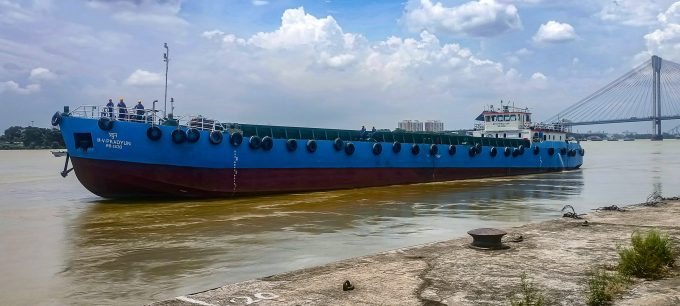Bangladesh looks at demurrage waiver as containers pile up in Chittagong
The Chittagong port yards now have close to 40,000 teu of containers, mainly loaded with ...
TFII: SOLID AS USUALMAERSK: WEAKENINGF: FALLING OFF A CLIFFAAPL: 'BOTTLENECK IN MAINLAND CHINA'AAPL: CHINA TRENDSDHL: GROWTH CAPEXR: ANOTHER SOLID DELIVERYMFT: HERE COMES THE FALLDSV: LOOK AT SCHENKER PERFORMANCEUPS: A WAVE OF DOWNGRADES DSV: BARGAIN BINKNX: EARNINGS OUTODFL: RISING AND FALLING AND THEN RISING
TFII: SOLID AS USUALMAERSK: WEAKENINGF: FALLING OFF A CLIFFAAPL: 'BOTTLENECK IN MAINLAND CHINA'AAPL: CHINA TRENDSDHL: GROWTH CAPEXR: ANOTHER SOLID DELIVERYMFT: HERE COMES THE FALLDSV: LOOK AT SCHENKER PERFORMANCEUPS: A WAVE OF DOWNGRADES DSV: BARGAIN BINKNX: EARNINGS OUTODFL: RISING AND FALLING AND THEN RISING

Coca-Cola is among the first shippers to benefit from a 40-60 teu inland waterway container service for India-Bangladesh cross-border trade.
Maersk Line has piloted a container-on-barge solution for Indian exports to its neighbour using the framework of a government-to-government “inland water transit and trade protocol”, designed to facilitate river transport along the Bay of Bengal.
The MV Pradyun transported 50 teu from Kolkata to Dhaka on behalf of Coca-Cola Bangladesh Beverages, according to Maersk (India).
“Cargo movement on inland waterways or rivers is much more reliable, especially in monsoons, when turbulent weather can cause delays on the ocean,” the carrier noted. “Moreover, with the ocean network under capacity pressure, the alternative inland waterway route that is quicker and more reliable has received a warm welcome from shippers.”
Maersk also claimed the waterway route would help avert the bottlenecks at the landside border crossings that typically hinder truck flows on both sides.
Vikash Agarwal, Maersk’s MD for South Asia, said: “We are expanding the opportunities for importers and exporters from the two countries with a faster, more reliable and safer option for their cargo.”
According to Angshuman Mustafi, head of Maersk Bangladesh, besides improving cross-border transit times by more than 60%, the customer had end-to-end, real-time shipment visibility, because of a daily data feed – an aspect of shipper predictability expectations.
“The negligible variations in these comparisons (estimates versus actuals) prove high reliability and have been thoroughly appreciated by our customers,” Mr Mustafi said.
Soumyendu Sen Sarma, director (finance) at Coca-Cola Bangladesh, added: “The delivery schedule of cargo, which used to be routed through the transhipment hub to Chittagong and further to the destination, used to be impacted severely with delays. The speed of delivery with the new solution over inland waterways is going to be extremely beneficial for us.”
Maersk officials believe the multiple benefits would drive up shipper interest in the barge mode. “We foresee a positive response from the customers and are looking at scaling up as the demand increases,” an official told The Loadstar.
“This offering also has the potential to become a two-way street opportunity in the long-term, given that Bangladeshi shippers are increasingly seeking transhipment alternatives to Colombo Port (Sri Lanka), due to ongoing disruption there.”
Some Bangladeshi transhipment cargo is already finding its way through eastern Indian ports, via available feeder connections.
The Indo-Bangladesh protocol framework has seen considerable government-level interventions in recent months, including for more harmonised and simplified customs rules to accelerate bilateral trade volumes.
Maersk has been at the forefront of using Indian inland waterway networks, currently on the cusp of expansion/modernisation, for intra-country container movement. Transporting containers between Kolkata and Varanasi via the Ganges river was one such effort, as industry stakeholders explore ways to reduce the trucking leg within the supply chain.
According to anecdotal information, 111 projects are in various stages of implementation by the Inland Waterways Authority of India. And, while India has an expansive countrywide river reach, its modal inland waterway share of domestic cargo transport is abysmally low – some 2%, compared with between 8% and 15% in other leading maritime countries.
You can reach the writer at [email protected]
Comment on this article